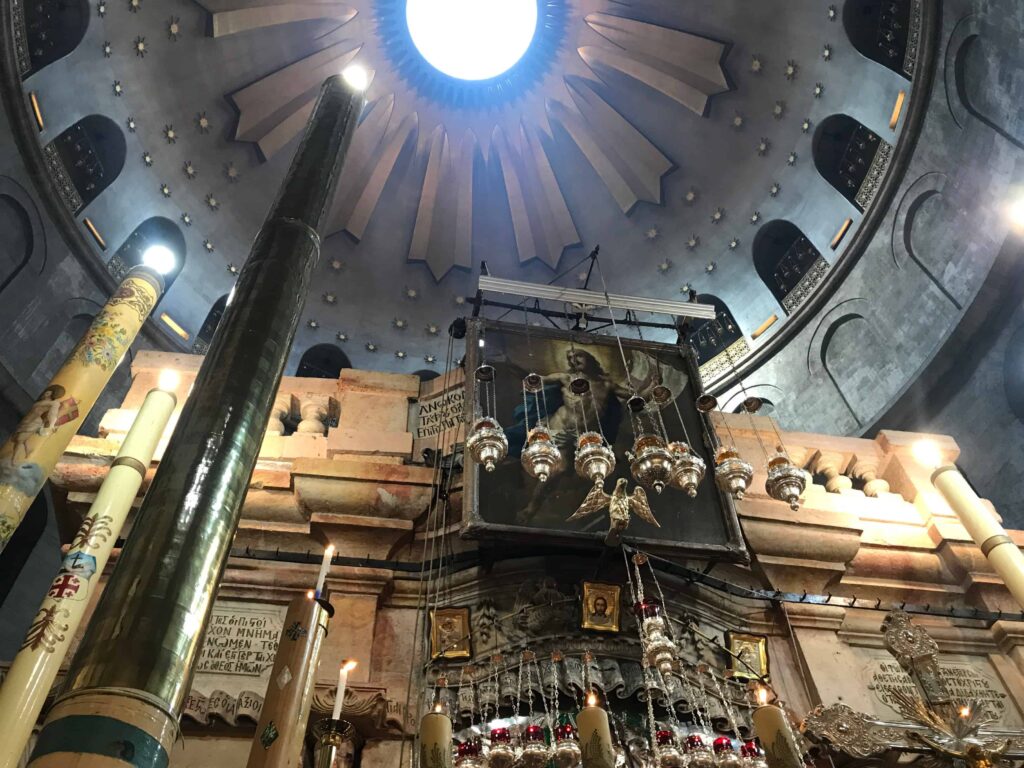
Armenian, Greek Orthodox and Catholic communities live inside the church of the Holy Sepulchre | I. Rodríguez
Nothing could be changed without the agreement of all Christian communities that share the places ruled by the Status Quo, but awaiting for that moment… “Almost 170 years have passed and an official agreement still has not been reached,” comments Fr. Salvador Rosas, who presides over the Franciscan community living in the Holy Sepulchre. A native of Mexico from Guadalajara, he remembers that what struck him the most when he first visited this church was the perspective: “Someone from Mexico imagines Mount Calvary like the Cerro de la Silla in Monterrey, an immense thing, and to see that it was five meters…”
This church is often considered to be the most important site of Christendom, as it houses Calvary and the Sepulchre, where Christ “was crucified, died, and was buried; and on the third day He rose again from the dead.” From the beginning, it has been a place shared by different Christian communities. In addition to the successive destructions and reconstructions resulting from centuries of history, the different areas of the temple have been changing their owners. “What was happening in the world also had repercussions here,” notes Fr. Rosas. “If Byzantium was the one that carried the reins of history, the Orthodox community won in that sense; if they were some European countries, they would look after the interests of the Western Church.”
“As with any house, there are rules”
The Holy Sepulchre is an irregular sanctuary, full of chapels, hidden corners, stairs that go up and down leading to the different and varied rooms, each of which has different administrators, as the Armenian, Orthodox and Catholic communities share the spaces.
The Status Quo gives rise to curious situations and particular elements: a ladder that stays several months in front of the Anointment Stone, another that is permanently in one of the windows of the facade, a schedule that needs to be strictly observed so as to avoid disturbing the hours of worship for the other communities, candles that only their owner can light…
“During the lockdown, we were able to pause and value the sanctuary so dear to Christendom that,
even if there were no people, it was alive.”
Despite the fact that maintaining these secular norms may seem absurd for some, Fr. Rosas affirms that “well lived, it has its reason for being. Carried out with good will, the Status Quo governs these sanctuaries like a house. There are rules, and if they are respected, there is a good coexistence.” Goodwill in complying with this unwritten law “works because by regulating times and spaces, it favors liturgy and celebrations.” For the Franciscans, there are three key moments of prayer: the morning mass, Vespers and the evening procession and the midnight prayer.
The pandemic effect
During the harshest points of the pandemic, one of the most distinct pictures of Jerusalem was that of the Holy Sepulchre shuttered tight. It was like this several months, with the communities living together inside. The sanctuary, usually full with the bustle of thousands of daily visitors, fell silent. “It united us,” assures Rosas, “we shared tea and coffee a few times; the Orthodox came to our house, we went to theirs; we usually make pizza on Sundays and we share them… There is a relationship. These are little things, but they help.”
On the personal and communitarian level, this year has been a time to “reevaluate our mission: why are we here?” The pre-pandemic frenetic pace of pilgrims led them to a “dynamic that was more worker-like, than religious.” However, thanks to the lockdown, they were able to pause and “value the sanctuary so dear to Christendom that, even if there were no people, it was alive.” Thanks to the Status Quo, “nothing was interrupted. We were just three singing in the procession, three celebrating all the masses… It helped us maintain our rhythm of prayer, to revalue things, to truly pray.”
Perhaps, as with many families, the pandemic has meant an “opportunity to dust off the essential things of life, to rest from the hustle and bustle, to see each other’s faces.” Fr. Rosas hopes that, with the gradual return to normality (or perhaps, the new normal), “better times will come” and that “the visit to the Holy Land, the visit to the Holy Sepulchre, will be the icing on the cake.” “We,” he adds, “revived in the spirit, will welcome you with greater joy.”
